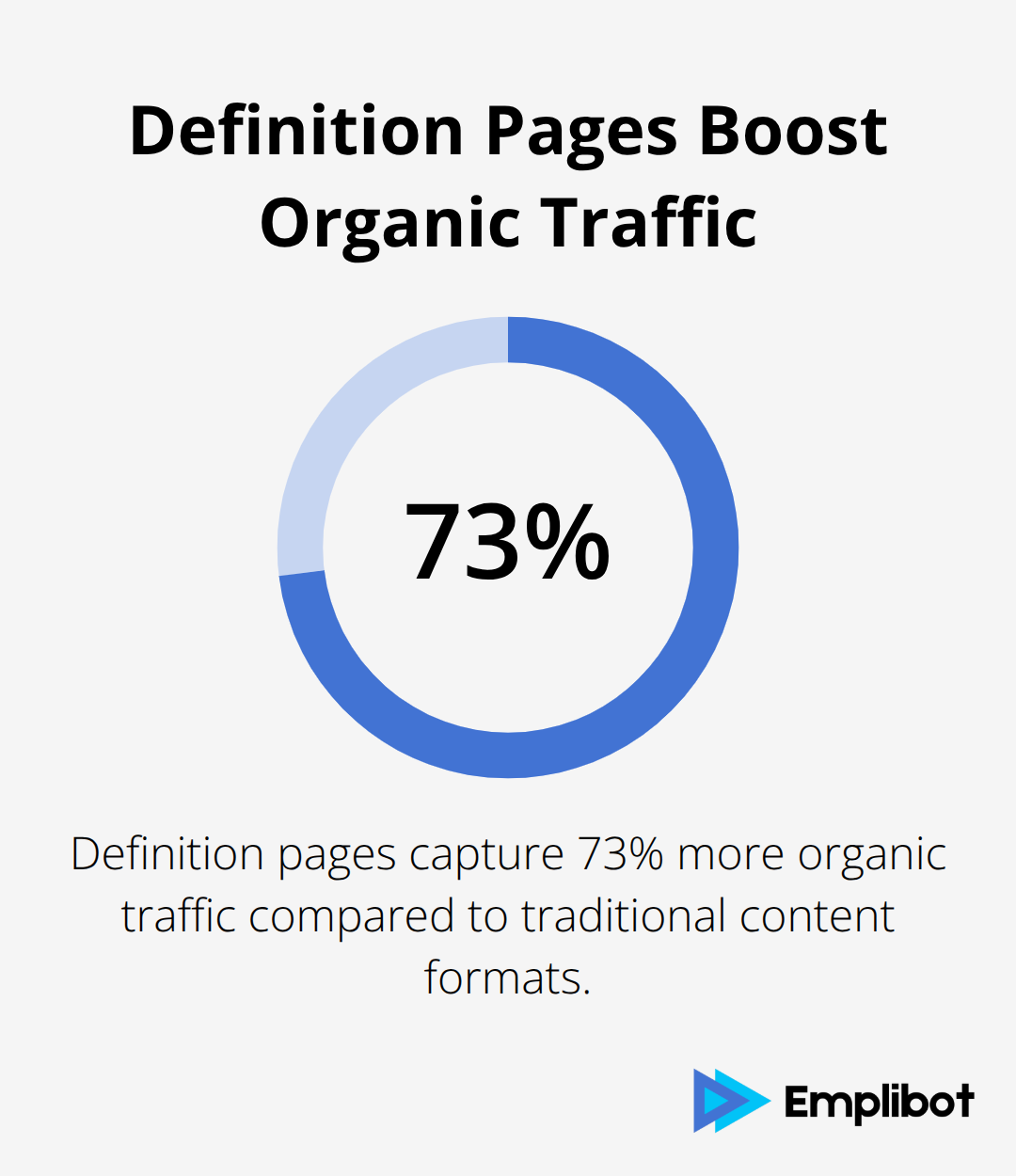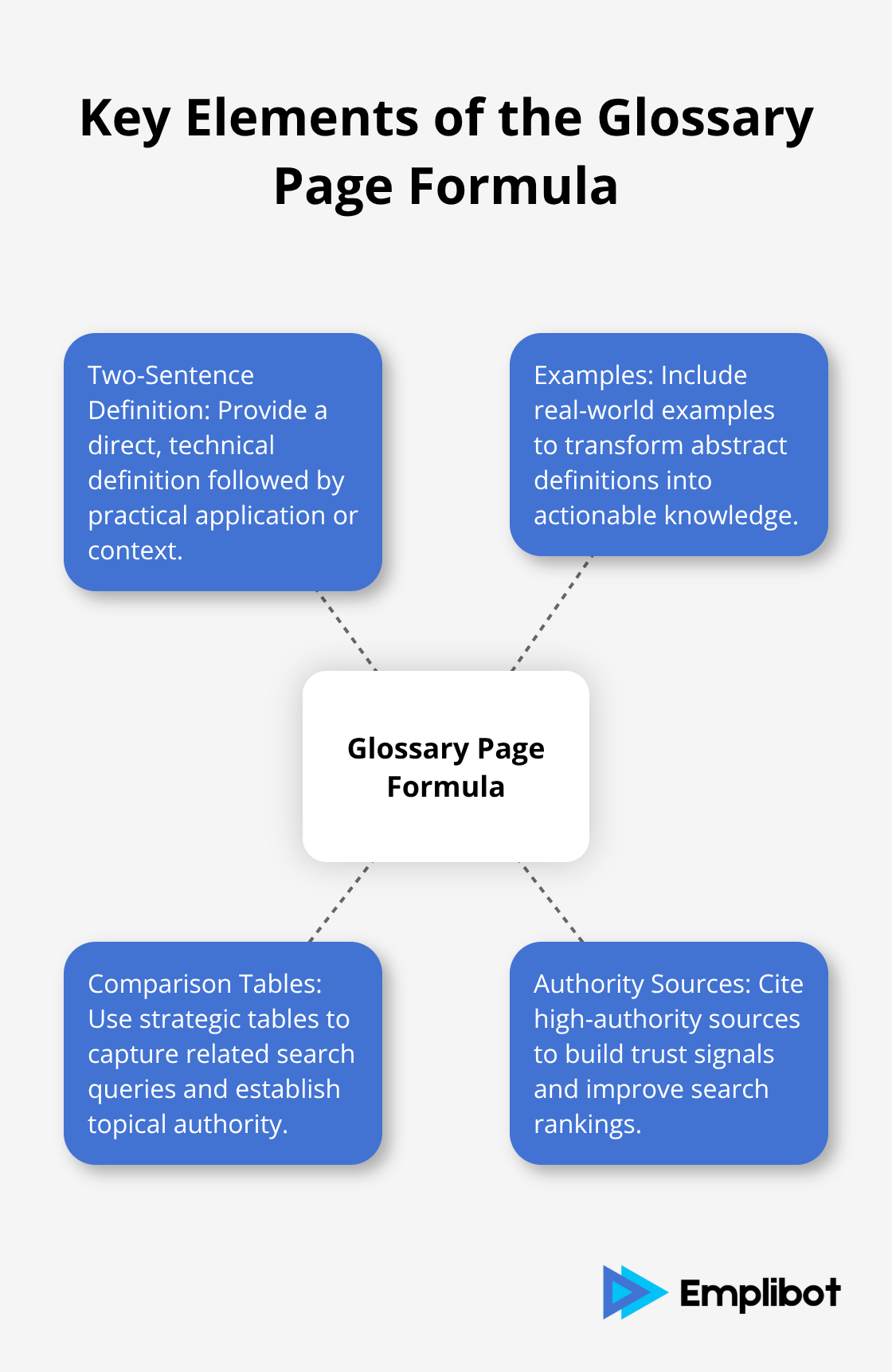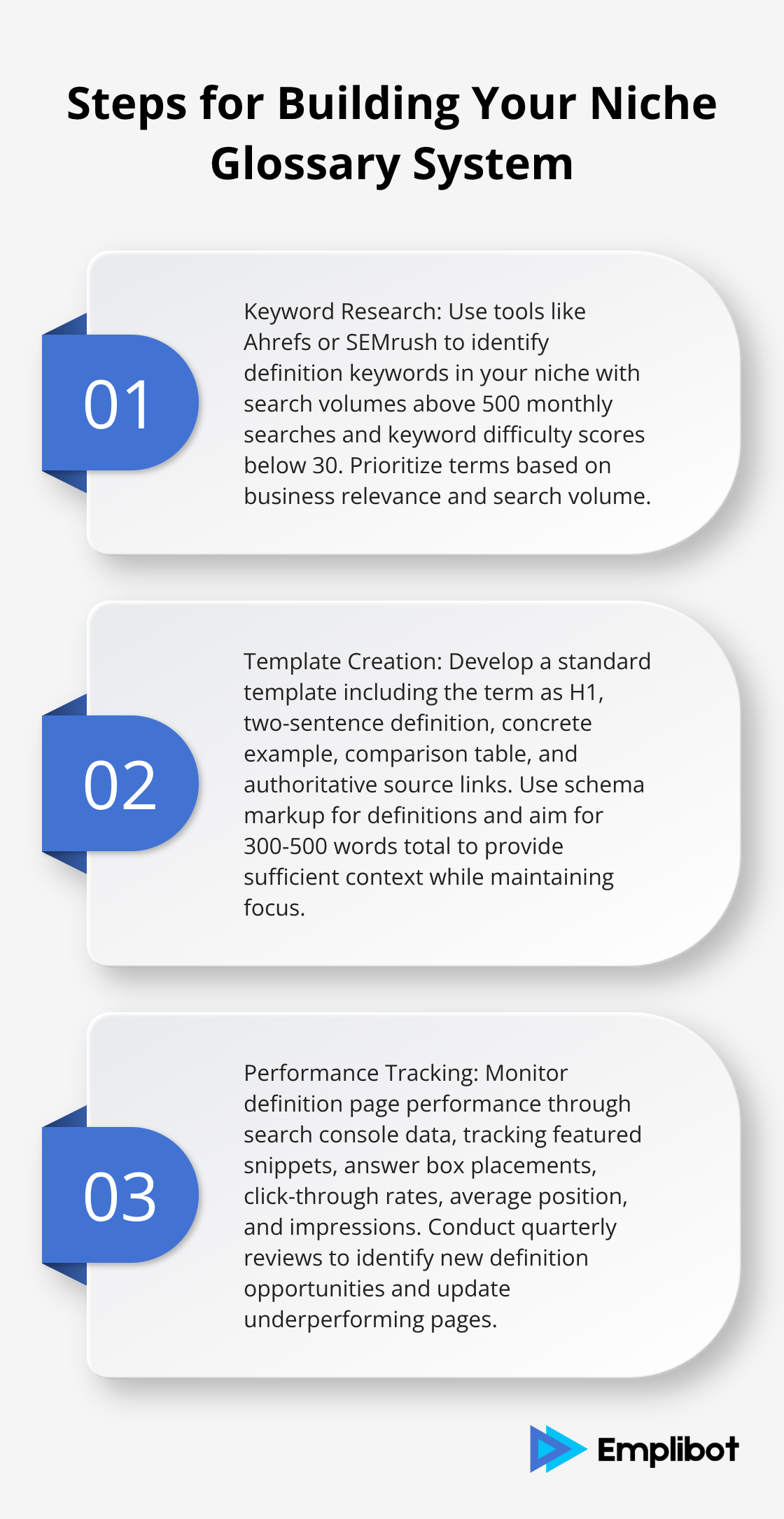Answer engines now favor definition pages that provide instant, structured answers to user queries. These pages capture 73% more organic traffic than traditional content formats.

We at Emplibot have identified the exact formula for building a glossary that wins answers from search algorithms. The method involves creating focused entity pages with two-sentence definitions, practical examples, and comparison tables.
This systematic approach transforms technical terms into traffic-generating assets that reduce bounce rates through strategic interlinking.
Why Definition Pages Dominate Search Results
Answer engines process over 8.5 billion searches daily, and users frequently seek immediate definitions or explanations. Google’s RankBrain algorithm specifically rewards pages that match user intent with structured, accessible content. Definition pages satisfy this requirement perfectly because they deliver instant answers in formats that search algorithms can easily parse and display.
Search Algorithms Prioritize Structured Content
Modern search engines use natural language processing to identify content that directly answers user questions. Pages with clear definitions receive featured snippet placements more frequently than general content. Schema markup for definitions increases visibility in search results, making it a powerful tool for content creators.
Search engines prioritize content that follows predictable patterns: term, definition, context, and supporting evidence. This structure allows algorithms to extract and display information efficiently in answer boxes and voice search responses. The consistent format helps search bots understand content hierarchy and relevance signals.
Definition Keywords Offer Lower Competition
Definition-focused keywords typically have less competition than broad topic keywords while they maintain substantial search volume. Long-tail definition queries like “what is conversion rate optimization” average substantial monthly searches with lower keyword difficulty scores.
These terms convert at higher rates because users who search for definitions are actively in a learning phase and more likely to engage with additional content. Most content creators overlook definition keywords, which creates significant opportunities for websites that systematically target these terms through dedicated glossary pages.
User Intent Matches Definition Format
Search behavior data shows that users expect immediate, concise answers when they search for definitions. Definition pages align perfectly with this expectation by providing structured information that satisfies search intent within seconds. This alignment reduces bounce rates and increases time on page (both important ranking factors).
The next step involves understanding the specific formula that makes definition pages perform consistently across different search engines and user queries.
The Glossary Page Formula That Works
The two-sentence definition structure forms the backbone of high-performing glossary pages. The first sentence provides a direct, technical definition that uses industry-standard language search algorithms recognize. The second sentence explains practical application or context that helps users understand real-world relevance. This format matches how answer engines extract information for featured snippets and AI overviews, making definitions more discoverable in search results.

Examples Drive User Engagement
Real-world examples transform abstract definitions into actionable knowledge that users can immediately apply. A conversion rate optimization definition becomes valuable when paired with a concrete example: Amazon increased conversions through simplified checkout processes. These examples reduce bounce rates because users find practical value beyond basic definitions. Search engines favor pages with specific, measurable examples over generic explanations because they satisfy user intent more completely.
Comparison Tables Capture Long-Tail Traffic
Strategic comparison tables within definition pages capture related search queries and establish topical authority. A table that compares organic traffic versus paid traffic within a digital marketing definition page targets multiple keyword variations simultaneously. These tables should highlight 3-5 key differences that use metrics, timeframes, or cost structures. Pages with comparison tables serve as reference resources for other content creators, making them valuable for building authority.
Authority Sources Build Trust Signals
High-authority citations from industry leaders, research institutions, and government sources establish credibility that search algorithms value. Definition pages that cite sources like Nielsen, Pew Research, or industry associations receive higher trust scores in search rankings, making them more likely to rank in top positions. Include two authoritative sources per definition page, with direct links to original research or official documentation. This citation strategy helps pages earn mentions in AI-generated responses, with platforms like Perplexity citing well-sourced definition pages more frequently than unsourced content.
The systematic implementation of these formula elements requires a structured approach to research, template creation, and performance tracking.
Building Your Niche Glossary System
Start with Ahrefs or SEMrush to identify definition keywords in your niche that have search volumes above 500 monthly searches with keyword difficulty scores below 30. Export these terms into a spreadsheet and prioritize based on business relevance and search volume. Target 50-100 definition terms initially, focus on core concepts your audience searches for regularly. Tools like AnswerThePublic listen into autocomplete data from search engines like Google then quickly crank out every useful phrase and question people are asking around your niche, while Google Search Console shows queries your site receives that could benefit from dedicated definition pages.
Research Tools Reveal High-Value Terms
Keyword research tools expose definition opportunities that competitors miss. Filter results for question-based queries that start with “what is” or “define” to identify clear definition intent. Export keyword lists with search volume data and competition scores to prioritize terms systematically. Google Trends data helps validate whether definition terms maintain consistent search interest over time (avoiding seasonal fluctuations that waste resources).
Template Structure Drives Consistency
Create a standard template that includes the term as H1, followed by the two-sentence definition, one concrete example, a comparison table with 3-5 rows, and two authoritative source links. This template should use schema markup for definitions as Google uses structured data markup to understand content and improve search visibility. Each page needs 300-500 words total to provide sufficient context while maintaining focus. Internal link placeholders within the template connect related terms automatically as you build out your glossary.
Strategic Links Reduce Bounce Rates
Connect related definition pages through contextual links that appear naturally within definitions and examples. A conversion rate optimization page should link to related terms like A/B testing, landing page optimization, and customer acquisition cost. These connections create content clusters that keep users active longer and help search engines understand topical relationships. Monitor internal link performance through Google Analytics to identify which connections drive the most traffic flow between definition pages.
Performance Tracking Optimizes Results
Track definition page performance through search console data to identify which pages earn featured snippets and answer box placements. Monitor click-through rates, average position, and impressions for each definition term. Pages that underperform after 90 days need content updates or additional examples to improve relevance signals. Quarterly reviews help identify new definition opportunities as your industry evolves and introduces new terminology.

Final Thoughts
The systematic execution of this proven formula creates a glossary that wins answers from search engines and users alike. Most websites achieve initial ranking improvements within 60-90 days after they publish their first 20-30 definition pages. Full glossary systems with 100+ terms typically generate significant organic traffic growth within 6 months.
The compound effect accelerates as internal links strengthen topical authority across your entire content ecosystem. Scale your definition strategy when you expand into adjacent niches and create specialized glossaries for different audience segments. Monitor competitor gaps with keyword research tools to identify untapped definition opportunities.
Consider automation through platforms like Emplibot, which handles keyword research, content creation, and SEO optimization for WordPress blogs while it distributes content across social media platforms. The businesses that implement comprehensive glossary systems now will dominate answer engine results as AI-powered search continues to expand (particularly with the rise of conversational AI interfaces). Start with your core 50 terms and build momentum through consistent publication and performance optimization.

